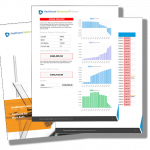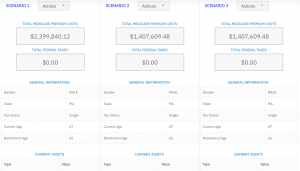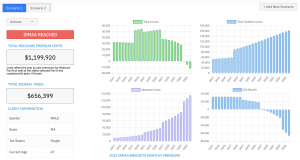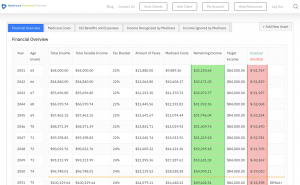Have you ever been surprised by a hike in your Medicare premiums? Felt like you were on an unexpected roller coaster ride with the is IRMAA calculated every year question hanging over your head? You’re not alone. Many folks find themselves perplexed by this annual riddle.
The Income-Related Monthly Adjustment Amount, or IRMAA, might seem as unpredictable as a wild horse at first glance. But there’s actually a method to its madness and understanding it can help tame that stallion.
This post is your trusty guide through the prairie of premium adjustments. We’ll navigate together across tricky terrain – from income brackets and tax returns affecting IRMAA calculations, to how Social Security gets involved, and even into appeal territory if things go south.
Keep reading for valuable insights on how to navigate the yearly recalculations and their nuances.
Understanding IRMAA Calculation
You might be asking, “Is IRMAA calculated every year?” The answer is yes. Each year, the Social Security Administration (SSA) uses a sliding scale based on your Modified Adjusted Gross Income (MAGI) to calculate any possible IRMAA surcharge.
The SSA takes into account different income brackets or ‘IRMAA Brackets’ as they’re often called. This establishes how much of your Medicare Part B and D premiums you must pay out, based on the MAGI income range. Higher income means more premiums paid.
This may seem daunting at first glance but don’t fret. It’s simply an extra fee for higher-income beneficiaries that help keep Medicare solvent.
Income Thresholds and IRMAA Calculation
Moving up in the world has its perks but it can also bump you into a new income threshold. That could lead to paying more for your Medicare coverage because of an increased IRMAA surcharge. But remember – everyone loves progress.
In fact, think of this like moving up from economy class on a flight where now there are just additional costs associated with those luxurious legroom seats upfront. You get better service perhaps even champagne- here in our case it helps fund medical care services nationwide.
Your Appeal Rights: Don’t Fear The Letter
If by chance you disagree with the initial determination about whether or not you should pay IRMAAA, fear not my friend; Uncle Sam lets us appeal these decisions too. And let me tell you, this isn’t a game of monopoly where we dread getting that letter in the mail.
Indeed, dealing with IRMAA appeals can feel like life has handed us lemons, especially when we experience a drop in income due to significant life events such as retirement or loss of pension. You can file an appeal with the SSA, which has made it more straightforward by providing a Life form. They have made this process simpler by providing a Life form for our use.
Key Takeaway:
Yes, IRMAA is calculated every year by the SSA using your MAGI and income brackets. The more you earn, the higher your Medicare premiums will be due to this surcharge. However, moving up in income can feel like upgrading on a flight – there might be additional costs but it’s all for better service. And don’t worry if you disagree with their calculations; there are avenues to dispute them.
Factors Affecting IRMAA Calculation
Understanding how your Income-Related Monthly Adjustment Amount (IRMAA) is calculated requires a bit of legwork. But don’t worry, we’re here to break it down for you. The SSA looks into a few elements when deciding if you should pay an additional charge on your standard Medicare premium, referred to as the IRMAA.
The IRS’s most recent federal tax return is an important factor in determining if you must pay an IRMAA surcharge. Each year, the SSA examines the most recent federal tax return that the IRS has available. For 2023, they’ll likely be looking at returns from two years prior — so keep those numbers handy.
If you’re married and filing jointly with your spouse, know that there’s a specific income threshold for determining whether or not you’ll owe IRMAA fees. According to Congressional Research Service Brief on MAGI for IRMAA, that limit was $194,000 as of 2023.
Filing Status Matters
Your filing status makes a difference too. If you file separately from your spouse or fall under any other category than ‘married couples,’ then the figure used by SSA drops significantly – all the way down to $97,000.
Gross Income Considerations
The SSA also pays close attention to gross income which includes everything from wages and self-employment earnings through pensions and annuities – even rental income gets thrown into the mix.
Digging Deeper Into Gross Income Calculations
In particular, they focus on modified adjusted gross income (MAGI). This value can seem like alphabet soup but think about it this way – it’s essentially your total income plus any tax-exempt interest.
It’s All About The Numbers
The bottom line is that the SSA looks at all these factors, crunches some numbers, and then sends you a notice if you need to pay an IRMAA surcharge. It might seem complicated, but understanding how this calculation works can give you a heads-up on what to expect when it comes time for your evaluation.
Key Takeaway:
Cracking the IRMAA Code: Your Income-Related Monthly Adjustment Amount (IRMAA) is calculated annually by SSA using your latest tax return. Key factors include your filing status and gross income, specifically Modified Adjusted Gross Income (MAGI). Understanding this can help you anticipate potential surcharges on top of standard Medicare premiums.
How Medicare Parts B & D Relate to IRMAA
The relationship between Medicare Part B, Part D, and the Income-Related Monthly Adjustment Amount (IRMAA) is directly tied to your income. Both parts of Medicare are subject to an additional charge known as the IRMAA if your income exceeds certain thresholds.
Medicare Part B covers doctor visits and outpatient care and has a standard premium that most people pay. But when you cross into higher income brackets – determined by Modified Adjusted Gross Income or MAGI – then the cost goes up due to IRMAA surcharges.
This means if you’re in a higher bracket for MAGI calculation, you will pay more for both Medicare Part B and Part D prescription drug coverage.
The Impact on Your Pocketbook
Your annual plan premium can increase because of these charges based on where your earnings fall within defined income limits. This makes it crucial not only from a healthcare perspective but also a financial planning one.
For instance, let’s say John Doe earns $87k annually; his monthly premiums for Part B might be around $148 plus any applicable Plan Premiums like those from Medicare Advantage Plans. But if he were making over $88k instead? His costs would jump significantly.
A Note About Calculation Frequency And Changes Over Time:
If there’s anything constant about health insurance expenses under this system, it’s change. The Social Security Administration recalculates every year whether you have to pay IRMAA. The Social Security Administration utilizes the most recent Internal Revenue Service-supplied federal tax return data annually to figure out if IRMAA payments are necessary.
Remember, a significant change in your income due to life-changing events can impact your monthly adjustment amount. In such cases, it’s worth exploring whether you could be eligible for a reduction in these charges.
In Conclusion
In conclusion, let’s…
Key Takeaway:
Medicare Part B and D premiums can increase due to the Income-Related Monthly Adjustment Amount (IRMAA) if your income exceeds specific limits. The Social Security Administration reviews this annually using IRS tax return data, so changes in your earnings may affect these charges. Keeping an eye on IRMAA’s impact is crucial for healthcare decisions and financial planning.
The Role of Social Security in IRMAA Calculation
The SSA is the entity responsible for assessing whether you are subject to IRMAA and, if so, determining how much extra your Medicare Part B or D premium will be. The SSA is in charge of deciding if you are eligible for IRMAA and, should it be the case, how much extra you must pay beyond your standard Medicare Part B or D premium.
The calculation process begins with an analysis of your Modified Adjusted Gross Income (MAGI). This includes tax-exempt income, like interest from certain bonds. Essentially, the SSA takes into account all sources of income reported two years prior. So if we’re talking about 2023 premiums, they would look at your 2023 tax return data.
This might lead you to question: why are they looking back two years? Well, this approach helps them assess changes in financial situations more accurately over time. However, there can be instances where current year’s earnings significantly differ from those documented two years ago due to life-changing events such as retirement or loss of income-producing property.
Notification Process by SSA
If the result suggests that you fall within one of the higher-income brackets defined by Medicare’s guidelines, then prepare yourself for an additional monthly charge. But don’t worry – before any surcharges apply; the SSA sends out written notifications detailing how much extra needs paying alongside regular Medicare premiums. These notices typically arrive towards end-of-year giving folks enough time for planning budget adjustments accordingly.
Filing For An Appeal
Sometimes though circumstances change and suddenly what was once affordable becomes unmanageable burden on pocketbook which raises question – Can I appeal my calculated IRMAA? Absolutely yes. If you experience a life-changing event that significantly reduces your income, you can file an appeal with the SSA using their Life-Changing Event form. This allows for possible recalculation based on more recent tax data or changes in marital status.
And that’s the scoop. Navigating through IRMAA can be quite a task, but now you’re better equipped to handle it.
Key Takeaway:
Understanding your Income-Related Monthly Adjustment Amount (IRMAA) involves the Social Security Administration and a deep dive into your income from two years prior. Expect notifications if you fall into higher-income brackets, but remember – if life changes cause financial strain, appeals for recalculations are possible. So keep calm and navigate IRMAA confidently.
Understanding Your Notice of IRMAA Calculation
You just got a letter from the Social Security Administration (SSA), and it’s about your Medicare premiums. Don’t worry, we’re here to explain what this means for your finances.
The notice is all about something called Income-Related Monthly Adjustment Amounts or IRMAA. This adjustment can increase your Medicare Part B and D premiums if you have higher income levels. The SSA calculates this every year, so let’s break down how they figure out who has to pay more.
Your Income Bracket Matters
The first thing to know is that not everyone will see an increase in their premium due to IRMAA. It all depends on where you fall within certain income brackets or thresholds.
If your modified adjusted gross income (MAGI) exceeds these limits, then brace yourself; you might need to pay up. For example, married couples filing jointly with a MAGI over $176,000 will likely face increased premiums as part of the 2023 rules include such provisions.
Premium Increase: What Does It Mean?
A notice from SSA indicating an increase in your premium doesn’t necessarily mean bad news—it simply means that based on recent tax return data, including total adjusted gross and tax-exempt income figures among others, the agency believes you’ve entered into one of those higher-income brackets that warrant extra charges under current legislation.
This calculation takes place each year using information from your tax returns two years prior. If you had a spike in income during that year—maybe due to selling property or other one-time events—it might have pushed you into an IRMAA bracket.
Disagree With The Decision?
No need to fret if this doesn’t appear correct. You’ve got the option to challenge the decision and ask for a fresh look, especially if significant life changes have happened.
Key Takeaway:
Just received a notice from SSA about your Medicare premiums and IRMAA? Don’t worry. This annual calculation considers your income level to adjust Part B and D premiums. If you’ve entered a higher-income bracket based on tax data two years prior, expect extra charges. But if it doesn’t add up, remember: You can always challenge the decision.
Appealing an IRMAA Determination
If you’re hit with a higher Medicare premium due to the Income-Related Monthly Adjustment Amount (IRMAA), don’t panic. You might be able to contest this decision.
The Social Security Administration uses your modified adjusted gross income (MAGI) from two years prior, but sometimes life throws us curveballs. Maybe you’ve had a life-changing event, like retirement or the death of a spouse? These significant changes can affect your MAGI and potentially lower your Medicare premiums.
Filing an Appeal for Reconsideration
To start the appeal process, first get yourself familiarized with form SSA-561-U2, also known as the Request for Reconsideration Form. This document allows you to make your case about why your IRMAA should be recalculated based on more recent financial data or specific circumstances that may have changed since filing taxes two years ago.
For example, if you were in a high-income bracket then but have now retired and are living off savings – well, let’s just say Uncle Sam shouldn’t still consider you “rich”. That’d feel pretty unfair.
Making Your Case Clear
In order to convince the powers-that-be that they’ve got it wrong this time around – remember: details matter. It’s not enough just saying “Hey my situation has changed.” – You need concrete numbers supporting how much less money is rolling in these days compared with when those pesky tax returns were filed.
Remember that documentation such as pay stubs or statements showing current income levels could be your best friend in this situation.
Don’t Take ‘No’ For an Answer
If your appeal gets turned down by the Social Security Administration at first, don’t lose hope. You still have rights to more reviews and possibly even a hearing if it’s necessary. It may feel like you’re in a David versus Goliath situation, but remember – bureaucracy is nothing more than ‘a system that can be navigated’.
Key Takeaway:
Facing a hike in Medicare premium due to IRMAA? Don’t fret. You can challenge this with the SSA using form SSA-561-U2, explaining why your situation warrants a reevaluation of your income from two years ago. Even if initially rejected, don’t give up – you have rights for more reviews and potentially a hearing.
The Impact of Income-Related Monthly Adjustment Amount (IRMAA) on Your Medicare Premiums
Did you know that if your income exceeds certain limits, you might have to pay IRMAA? That’s right. Higher income folks may find themselves subject to an additional charge. This can be quite a surprise when opening up that Social Security check.
Your modified adjusted gross income or MAGI plays a significant role in determining whether this surcharge applies. But it’s not just about the numbers; married couples filing jointly get treated differently than single filers. It all boils down to those tricky income thresholds set by the Social Security Administration each year.
You’re probably asking, “How does my social security benefits impact my IRMAA?” Well, here’s where things start getting interesting. The SSA calculates IRMAA based on your tax return from two years prior – talk about time travel.
- If you’re a high earner and are curious how much more you’ll need to fork out for Medicare Part B and D premiums due to IRMAA, then brace yourself – there is indeed a sliding scale at play.
- If however, life threw some curveballs at you such as marriage, divorce or retirement which resulted in reduced earnings compared with two years ago; good news. You could potentially ask for reconsideration using the Life-Changing Event form.
Understanding the Numbers Behind IRMAA Calculation
In 2023 alone, individuals earning over $91k or married couples above $182k will begin paying extra fees ranging from $12.30 to a whopping $77.10 per month on top of their standard Medicare Part B premium.
But the story doesn’t end there. IRMAA also influences your Medicare prescription drug coverage. You might see additional charges ranging from just a few dollars to significantly more.
Key Takeaway:
But there’s a silver lining. Even if you’re in the high-income bracket, don’t panic. There are strategies to help reduce or even avoid these extra charges. It just takes some planning and perhaps professional advice.
FAQs in Relation to Is Irmaa Calculated Every Year
How often is Irmaa reviewed?
The Social Security Administration reviews IRMAA every year, considering your tax returns from two years prior.
How is irmaa calculated for 2023?
IRMAA calculation for 2023 uses the modified adjusted gross income (MAGI) on your most recent tax return to set Medicare Part B and D premiums.
Is Irmaa a one time payment?
No, IRMAA isn’t a one-time fee. It’s an extra charge added to your monthly Medicare Part B and D premiums if you’re in higher income brackets.
Does Medicare Part B premium change every year based on income?
Absolutely. Your yearly income affects both parts of your Medicare coverage: Parts B & D, which can lead to changes in premium costs annually due to IRMAA calculations.
Conclusion
Decoding the annual IRMAA calculation is like mastering a puzzle. And you’ve got it! Yes, IRMAA is calculated every year, based on your income thresholds and tax returns.
Your Medicare premiums – Parts B and D specifically – feel this impact directly. The Social Security Administration plays a crucial role in this equation, examining your adjusted gross income from two years prior to determine if an IRMAA surcharge applies.
You now know what that notice of calculation means for you, and how to handle it effectively. If things seem off-kilter, there’s always room for appeal with forms such as the life-changing event form or request for reconsideration form at hand.
The key takeaways? Understand your income bracket, keep track of any changes in earnings, stay alert about notices from SSA and remember – appealing an unfair determination is possible!
Table of Contents:
- Understanding IRMAA Calculation
- Factors Affecting IRMAA Calculation
- How Medicare Parts B & D Relate to IRMAA
- The Role of Social Security in IRMAA Calculation
- Understanding Your Notice of IRMAA Calculation
- Appealing an IRMAA Determination
- The Impact of Income-Related Monthly Adjustment Amount (IRMAA) on Your Medicare Premiums
- FAQs in Relation to Is Irmaa Calculated Every Year
- Conclusion
Streamlining the Medicare Surcharge Calculation Process.
Our Healthcare Retirement Planner software is designed to streamline the retirement planning process for financial professionals. By providing an efficient way to calculate IRMAA costs, our tool helps you save time and focus on other aspects of your clients’ retirement plans.
- Faster calculations: Our software quickly calculates IRMAA costs based on your client’s income and tax filing status, eliminating manual calculations and potential errors.
- User-friendly interface: The intuitive design of our platform makes it easy for financial professionals to input data and generate results with minimal effort.
- Data integration: Seamlessly integrate our calculator into your existing financial planning tools or CRM systems for a more streamlined workflow.
- Easy to Understand Reports: Export reports to easily share with your clients
- Tax and Surcharge Modeling: see how different types of income affects both taxes and your surcharges.
In addition to simplifying the calculation process, using our Healthcare Retirement Planner can also help improve communication between you and your clients. With clear visuals that illustrate how IRMAA costs impact their overall retirement plan, you can effectively convey complex information in an easily digestible format. This enables clients to make informed decisions about their healthcare expenses during retirement while ensuring they are prepared for any potential changes in Medicare premiums due to income fluctuations. To learn more about how our software can benefit both you as a financial professional and your clients’ retirement planning experience, visit the features page. Streamlining retirement planning processes can help financial professionals save time and resources, allowing them to focus on other areas of their clients’ needs. Automated calculation of IRMAA costs is the next step in streamlining this process even further.






